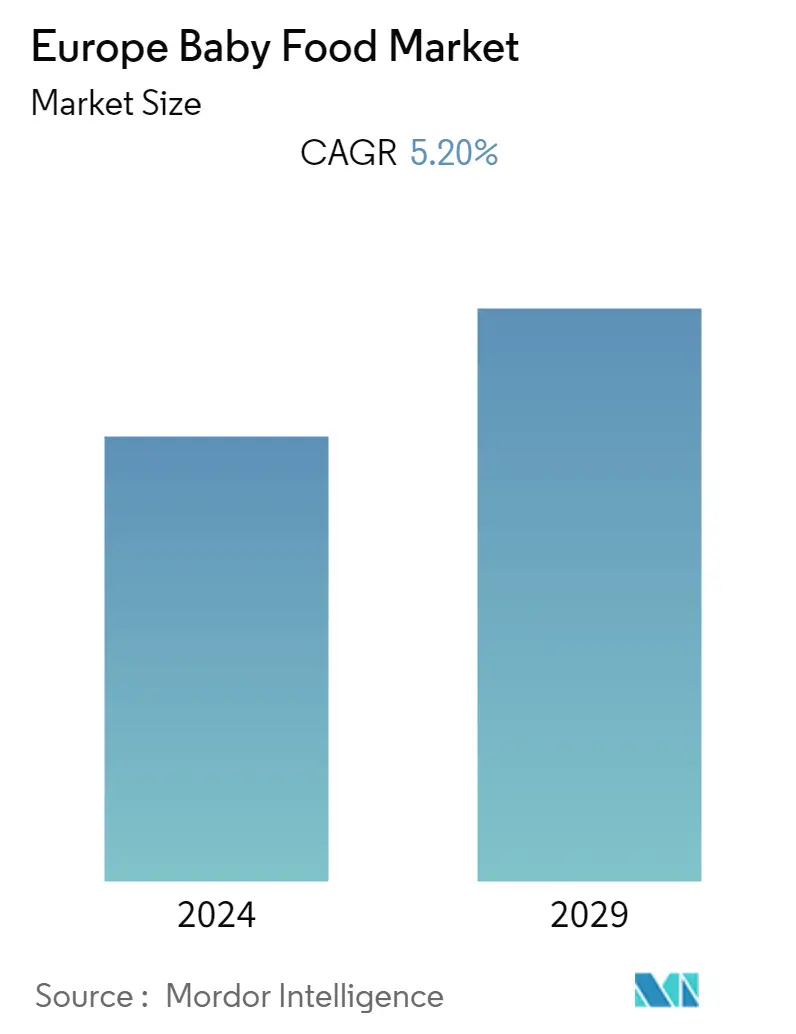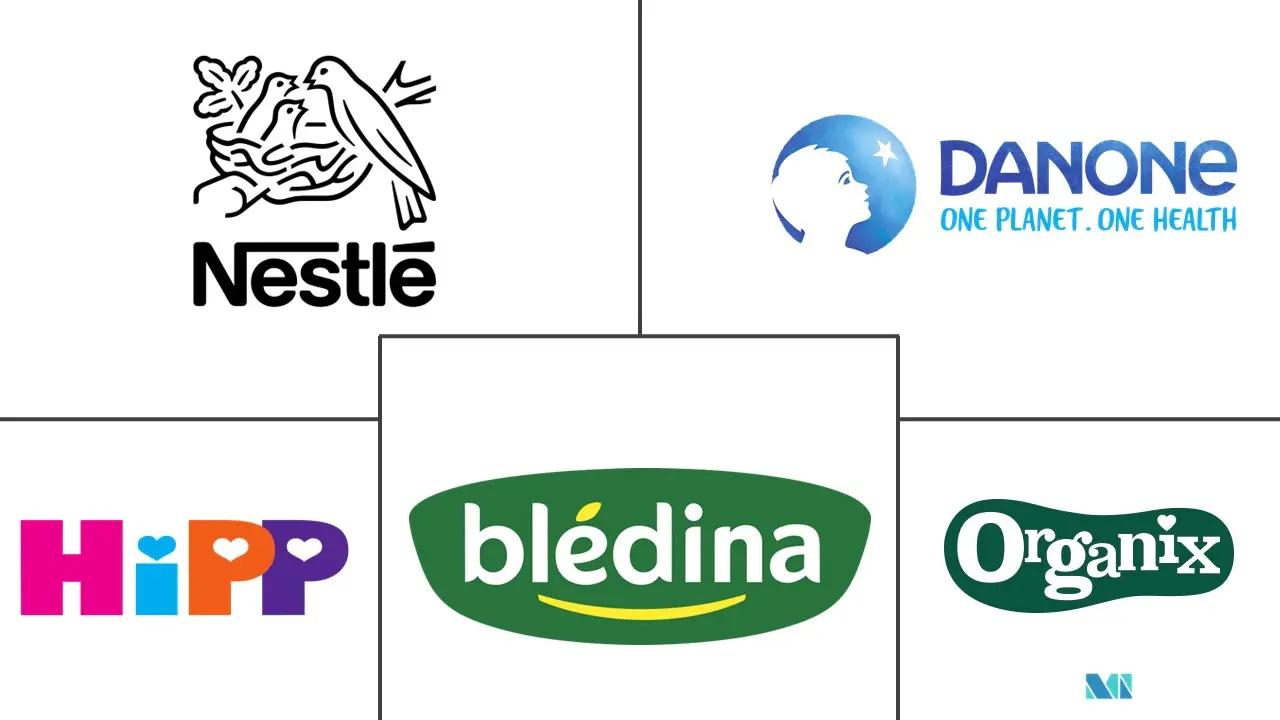Market Size of Europe Baby Food Industry

| Study Period | 2019 - 2029 |
| Base Year For Estimation | 2023 |
| Forecast Data Period | 2024 - 2029 |
| Historical Data Period | 2019 - 2022 |
| CAGR | 5.20 % |
| Market Concentration | Low |
Major Players
*Disclaimer: Major Players sorted in no particular order |
Europen Baby Food Market Analysis
The Europe baby food market is expected to register a CAGR of 5.2% during the forecasted period.
- The demand for convenience, variety, and more nutritional baby food is a factor driving the increasing consumption of baby food. The growth of the middle class and the rising working female population are also factors boosting the market. Consumers are more conscious about the baby's health, which increases demand for natural, vegan, and organic baby food. In response to the growing demand for organic and vegan baby foods, manufacturers are developing new products to expand their market share.
- For instance, in June 2021, Heinz announced the launch of a plant-based baby food line in the United Kingdom that is 100% natural. The Heinz for baby pulses line has three options: saucy pasta stars with beans & carrots, potato bake with green beans & sweet garden peas, and risotto with chickpeas & pumpkin. None of the three options contain added sugar or salt.
- Furthermore, safety measures in terms of baby food packaging are a significant concern among young mothers. Eco-friendly packaging is gaining traction, supporting various major companies to discriminate the products in the market. Moreover, the trend of baby food in ready meals is expected to witness a strong penetration rate over the years.
- The European baby food market is highly regulated, which makes baby food the safest to consume. Stringent and changing regulations have also caused distortions in the market Germany, Russia, and the United Kingdom hold a significant share of the European baby food market.
Europen Baby Food Industry Segmentation
Baby food can be described as soft and easily consumed food manufactured from natural or organic ingredients or formula.
The market is segmented by type, distribution channel, and country. Based on type, the market is segmented into milk formula, dried baby food, prepared baby food, and other types. Based on the distribution channel, the market is segmented into hypermarkets/supermarkets, drugstores/pharmacies, and convenience stores. The study also covers the European market analysis of the major regions, including Spain, the United Kingdom, Germany, France, Italy, Russia, and the Rest of Europe.
For each segment, the market sizing and forecasts have been done based on value (in USD Million).
| Product Type | |
| Milk Formula | |
| Dried Baby Food | |
| Prepared Baby Food | |
| Other Product Types |
| Distribution Channel | |
| Supermarkets/Hypermarkets | |
| Pharmacies And Drug Stores | |
| Convenience Stores | |
| Online Retail Stores | |
| Other Distribution Channels |
| Country | |
| Spain | |
| United Kingdom | |
| Germany | |
| France | |
| Italy | |
| Russia | |
| Rest of Europe |
Europe Baby Food Market Size Summary
The European baby food market is experiencing significant growth, driven by increasing demand for convenience, variety, and nutritional value in baby food products. The rise of the middle class and a growing population of working women are key factors propelling market expansion. Consumers are increasingly prioritizing their baby's health, leading to a surge in demand for natural, vegan, and organic baby food options. Manufacturers are responding to this trend by developing innovative products, such as plant-based baby food lines, to capture a larger market share. Safety and eco-friendly packaging are also becoming important considerations for consumers, further influencing product offerings. The market is characterized by stringent regulations, ensuring high safety standards, with major markets in Germany, Russia, and the United Kingdom.
The market is highly competitive, with leading players like Danone, Nestle, and H.J. Heinz dominating the landscape. These companies are expanding their product portfolios to include organic and natural baby foods, leveraging technological advancements in product development. The demand for ready-to-eat and instant baby food options is on the rise, driven by the need for convenience among parents. Sustainable packaging solutions are gaining traction, reflecting growing consumer awareness of environmental issues. The market's growth is supported by strategic mergers, acquisitions, and product innovations, as companies strive to enhance product quality and expand their presence across Europe.
Europe Baby Food Market Size - Table of Contents
-
1. MARKET DYNAMICS
-
1.1 Market Drivers
-
1.2 Market Restraints
-
1.3 Porter's Five Forces Analysis
-
1.3.1 Threat of New Entrants
-
1.3.2 Bargaining Power of Buyers/Consumers
-
1.3.3 Bargaining Power of Suppliers
-
1.3.4 Threat of Substitute Products
-
1.3.5 Intensity of Competitive Rivalry
-
-
-
2. MARKET SEGMENTATION
-
2.1 Product Type
-
2.1.1 Milk Formula
-
2.1.2 Dried Baby Food
-
2.1.3 Prepared Baby Food
-
2.1.4 Other Product Types
-
-
2.2 Distribution Channel
-
2.2.1 Supermarkets/Hypermarkets
-
2.2.2 Pharmacies And Drug Stores
-
2.2.3 Convenience Stores
-
2.2.4 Online Retail Stores
-
2.2.5 Other Distribution Channels
-
-
2.3 Country
-
2.3.1 Spain
-
2.3.2 United Kingdom
-
2.3.3 Germany
-
2.3.4 France
-
2.3.5 Italy
-
2.3.6 Russia
-
2.3.7 Rest of Europe
-
-
Europe Baby Food Market Size FAQs
What is the current Europe Baby Food Market size?
The Europe Baby Food Market is projected to register a CAGR of 5.20% during the forecast period (2024-2029)
Who are the key players in Europe Baby Food Market?
Nestle SA, Hipp GmbH & Co Vertrieb KG, Danone S.A., Organix Brands Company and Bledina Company are the major companies operating in the Europe Baby Food Market.

